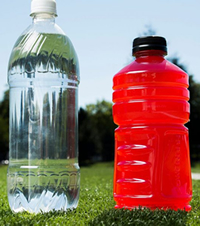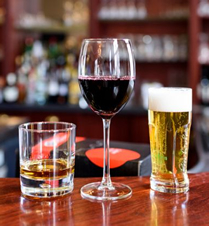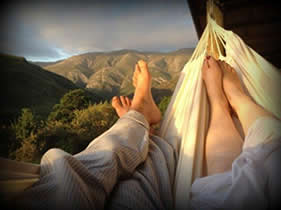
#1: Drink Lots of Water

Whether you're traveling through, overnighting, or engaging in any activities in the Rocky Mountain region, it's critical that you drink a lot of water. Don't wait to get thirsty to decide you need a drink either. Sip frequently and track your intake in ounces so you know you're sufficiently hydrated every day you're at higher elevations. When hiking, biking, swimming, or engaged in other physical activities, it's easy to lose track of your hydration level, so it's really important that you monitor what and how much you're drinking. If you're super active and working up a sweat, it doesn't hurt to rotate into your consumption a sports drink containing electrolytes. Coloradans are also partial to Colorado water, however, one should always purify it if/when taking directly from a natural source such as a mountain river or stream...purification tablets are cheaper than a trip to the ER.
If you have not yet arrived in Colorado, it is a good idea to increase your water intake 2-3 days ahead of your arrival. It will aid in adjusting properly and getting accclimated more rapidly if you're properly hydrated prior to your arrival. Drink more than you would normally...and then have just a little more.
#2: Monitor Alcohol-Intake

At higher altitudes, it is very easy to get super tipsy rapidly — completely by accident. Effects of alcohol feel more pronounced at higher elevations. With the presence of so many great breweries, distilleries, and wineries in Colorado, managing one's consumption can be particularly tricky. That, however, doesn't necessitate total abstinence. If, for example, you wish to try several beer options in a brewery, ask for a "flight" — small samples of multiple brews. When you do imbibe, take it slow and match your alcohol consumption with an equal amount of water and never drink on an empty stomach. Should you start to feel woozy, slow your pace and drink some water. The wine, whiskey, and beer aren't going anywhere so one need not try to "have it all" in just one sitting.
Another reason one at higher altitudes might feel impacted by alochol more rapidly than usual may be the strength of the spirits. Some beers can have an ABV that is triple that of other retail options found in the liquor store. The majority of brewers do, however, list the individual ABV of their beer allowing one to take care in his/her selections.
#3: What Are You Eating?
Enjoy great food? Who doesn't? The mountain communities offer a plethora of great dining options, ranging from mobile food trucks to quick-serve restaurants to some of the finest dining in the Rockies. One thing to keep in mind when sampling and enjoying such delectables is to limit your salt and increase your carbohydrate intake while in the region. That doesn't mean loading up on the doughnuts or burgers and fries. Balance satisfying your sweet tooth, alochol consumption, and the tempting road-trip munchies with foods that aid in elevating your alertness and energy levels. Foods such as avocado, bananas, bran, broccoli, cantaloupe, celery, dates, dried fruit, granola, greens, potatoes, and tomatoes will help replenish electrolytes through balancing salt intake.
The summer months offer many farmer's markets throughout mountain communities where one may find a superb selection of locally grown, organic produce that include fresh fruit, vegatables, meat, beverage, and healthy snack options.
#4: Just Arrived — Now Slow Your Roll

Welcome to Central Colorado! Now, take a moment to take it easy. No, we're not trying to be inhospitable, but rather help you enjoy your visit, stay healthy, and maximize your fun. Seldom can one arrive today and expect to ascend a 14,000 foot peak (or possibly a lengthy hike on an inclined nature trail) the next day. Such actions rarely result in one enjoying a pleasant experience. No one enjoys spending their vacation time ailing in bed, or worse the hospital. While your mind and spirit may be eager to experience all Central Colorado has to offer, your body likely requires some time to adjust to functioning in low-oxygen environments and dry climate conditions. Are you a runner? Recommended pace for visitors is around 50% of your normal run time, particularly if running in hilly or mountainous terrain. Start off slow and then increase daily. Allowing your body to acclimate to the altitude will result in a more enjoyable visit. To start, plan activities and visits to attractions that put you in the chill-zone for your first few days, saving active engagements and high elevation activities for the latter portion of your visit.
#5: The Sun is Intense
Many visit our Great State to escape the heat and humidity synonimous with other areas of the country, drawn by the cooler temperatures and crisp mountain air. However, Colorado enjoys over 300 days of sunshine, climate is dry, and our elevation puts us closer to the sun. And, yes, sunburns still occur when it's cooler outside. Just ask any snowboarder or skier about strong the sun can be in the winter. Their goggle tan lines will be a dead giveaway. As your likelihood of sunburn is increased at higher altitudes, it is imperative that proper head covering, sunglasses, and frequent applciation of sunscreen are part of your outdoor engagements.
As is the case anywhere, the sun is most brutal at noon. Most find that physical activities are most enjoyable around or shortly after dawn or in late afternoon. If possible, save your driving tours and more relaxing activities for around mid-day.
#6: Pet Safety at High Altitude

It is not uncommon for visitors to bring their pet along to share in the enjoyment of Central Colorado. The region offers many dog-friendly activities, attractions, and sites that you and your best friend may take advantage of. However, it is important to bear in mind that if, like you, high altitude is a new experience for your pet, you will need to apply the same rules above (minus alcohol consumption and application of sunscreen...tends to make them grumpy when it sticks to their fur). It is equally imperative that your pet consumes lots of water, gets plenty of rest, and has frequent opportunties to refuel. Additionally, never, ever leave your pet inside a vehicle regardless of how mild you believe it to be outside. Despite a cooler temperature outside, the inside of a vehicle can get very hot, very rapidly. As a pet-friendly region, Central Colorado offers plenty of businesses and patios that happily welcome your pet so there is no need to stress them out in your hot vehicle. Ensure your pet has frequent opportunities for rest breaks and shade when active in the outdoors. Please be aware of when and where leash rules are applicable and follow posted waste-pickup policies so that other pets and patrons may enjoy the outdoor resources as well.